When I told people we were planning to go to Iceland in early February for my partner’s 40th birthday I got a lot of puzzled looks. Won’t you freeze? they asked. Won’t it be dark all the time?
I was a bit worried about visiting Iceland in winter, but I needn’t have been. February (and winter as a whole) is one of the best times to go to Iceland.
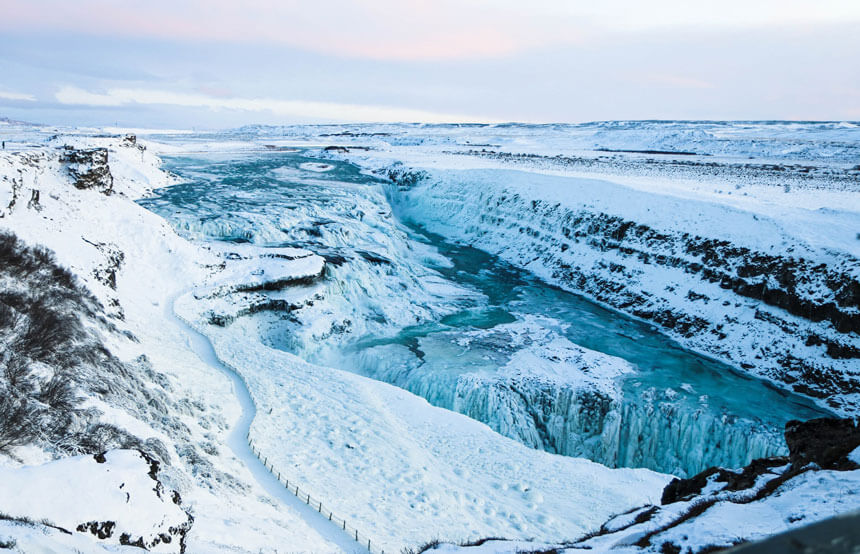
While you’ll need to be prepared, seeing Iceland in winter is absolutely magical, with lots of incredible experiences that are either at their best in the winter, or are only possible in the colder months.
Here’s everything I learned about planning a trip to Iceland in winter, and advice for your winter trip. Get wrapped up and let’s go!
Pros and cons of visiting Iceland in winter
Some of the advantages of visiting Iceland in the winter months:
- some activities, like seeing the Northern Lights and going inside a glacier cave can only be done in winter
- it’s a quieter time, so the top sights won’t have as many people around…
- …and hotels can be a bit cheaper during the off-peak months, helping your money go further
- the snowy landscapes are absolutely stunning – think frozen waterfalls and dramatic mountains
- Reykjavik is particularly charming when it’s been snowing, especially when the Christmas lights are on (and many people keep their festive lights on into February)
- taking a steamy dip in an outdoor thermal spa while snow falls around you is a once-in-a-lifetime experience
And the disadvantages:
- if the weather is particularly bad, some activities could be cancelled
- the days are very short in midwinter – great for spotting the Northern Lights, not so great for packing lots of sightseeing in each day
- you’ll definitely need good winter clothing. If you don’t already own a warm coat and boots it could add an extra expense to your trip.
- some roads may be closed, but they’re unlikely to be ones you’re using as a visitor
- if you do plan to drive, you’ll need to know how to drive in wintry conditions
How cold is Iceland in winter?
The surprising answer is that it’s really not that cold (honestly). It can be windy, and snowy, and you’ll definitely want to wrap up warm, but at no point did I feel in danger of getting frostbite.
While Iceland is only just below the Arctic Circle, the Gulf Stream flows around the western side of the island, keeping it warmer than you might expect at this latitude. The effect is more pronounced on the west and southern coasts – and happily, that’s where most visitors spend most of their time.
The average high temperature in Reykjavik between November and March is between 2 and 5°C (36-41°F), while the low is between 0 and -3°C (27-32°F). It’s colder outside the city, particularly in very exposed places (the black sand beach at Reynisfjara near Vik was probably the coldest place we visited), but still very manageable if you’re dressed for it. We live in northern England and I’ve definitely experienced colder weather here than we had during our February trip to Iceland.
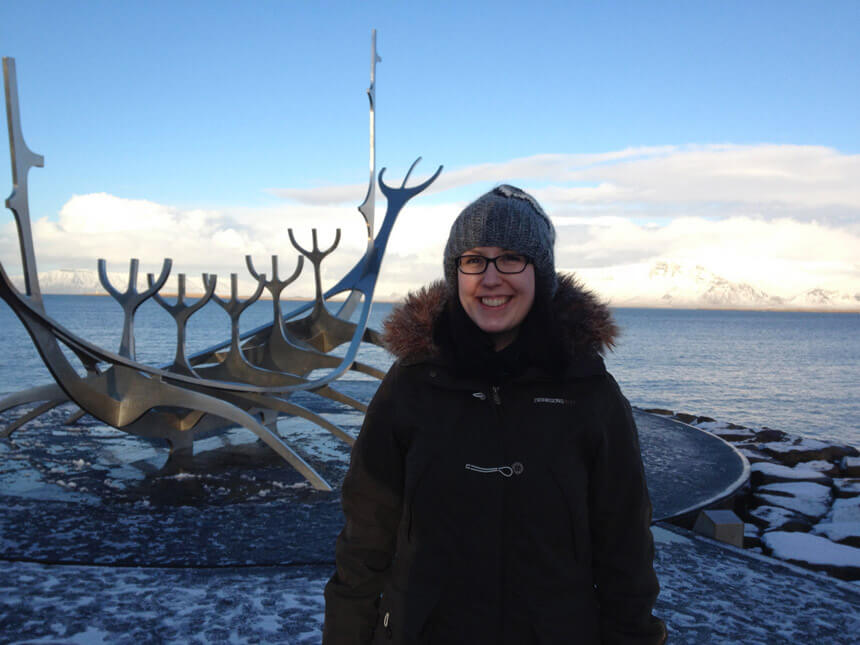
How dark is wintertime in Iceland?
Don’t worry, the sun does come up even, even on the shortest day of the year in December. The winter solstice sees the sun rise at around 11am and set around 5 hours later. By early February, Reykjavik gets around 8 hours of daylight, although it’s never very strong. There’s plenty of daylight time to sightsee around Reykjavik and do a Golden Circle tour.
If you’re looking at a longer day tour from Reykjavik like the Southern Iceland tour we did, you’ll probably find that you’re leaving Reykjavik in the dark and coming back in the dark, but it’ll be light for the main sights. Anyway, if it didn’t get dark, how would you see the Northern Lights?
Things to do on your winter trip to Iceland
There’s very little that you can’t do in Iceland during winter and a few things that can only be done in the coldest months – making winter the perfect time to visit this astonishing island.
1. See the northern lights
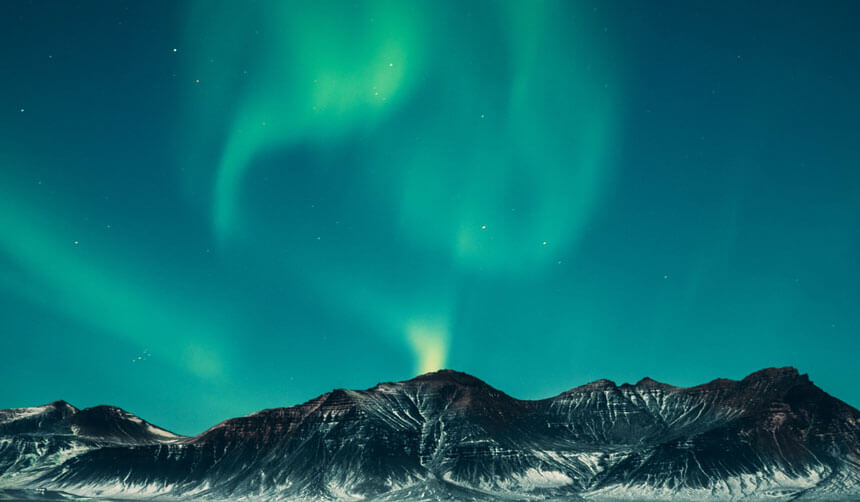
Seeing the northern lights is the number one reason to choose winter for your trip to Iceland. They can be spotted any time between October and April, although the peak time is between December and March.
We took a late night bus tour out of Reykjavik into the Þingvellir national park, where our driver tried to find us a good place to spot the lights. Unfortunately we only got a very brief and faint show, so I asked Sophie from We Dream Of Travel to tell me about their experience:
“One of the main reasons we chose to visit Iceland in winter was for photographing the northern lights.
“The northern lights are typically most visible in Iceland during the winter, when the long nights add to the chance of being able to witness this natural phenomenon.
“There are few experiences that compare to first witnessing the northern lights dancing majestically above you, or even seeing them for a second or third time! The sky seems to come to life with colours swooping and swirling above you. It feels like mother nature is putting on her own magic show.
“However, the northern lights were more elusive than we’d expected. While finally seeing the aurora borealis dancing in the sky is truly a once-in-a-lifetime experience, it is worth managing expectations and being aware that you may not get to see them. There are many conditions that need to perfectly align, including weather conditions, cloud cover, aurora activity and your location!
“If your primary reason for visiting Iceland in winter is to see the northern lights, it is well-worth either booking a tour or ensuring you have your own vehicle and an app that will alert you to any expected lights. This way you can make sure if there is solar activity, that you can be in the right place at the right time!
2. Do a Golden Circle tour
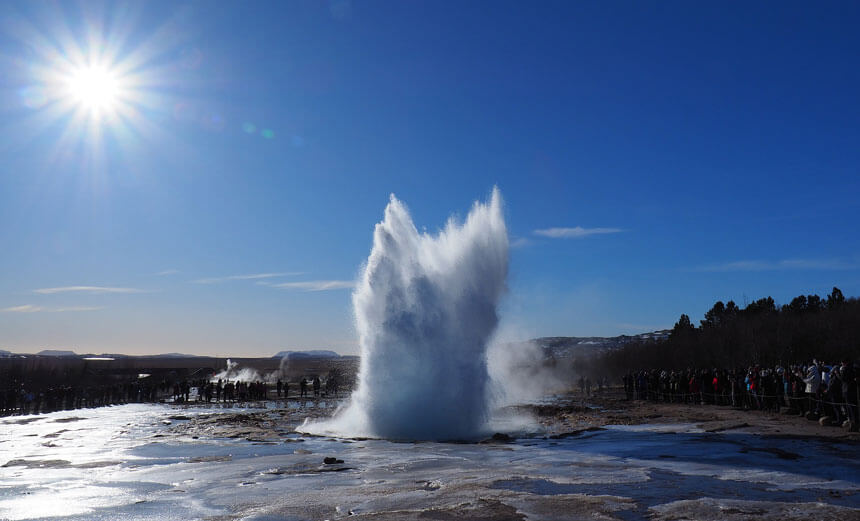
The Golden Circle tour is one of the most popular activities for visitors to Iceland at any time of year, and you can still do a Golden Circle tour in all but the very worst of Iceland’s winter weather.
Golden Circle tours include three of Iceland’s most famous sights:
- the Þingvellir National Park, where the European and North American continents meet and where the world’s first democratically elected parliament that remains in operation first sat in 930AD
- the 32-metre (105 feet) high Gulfoss waterfall
- the Geysir Geothermal Area, where you can see the Strokkur geyser blasting a column of hot water 40 metres (130 feet) into the air
Longer versions of the tour often visit the Kerið crater lake, which freezes over in winter.
The Golden Circle is a very popular route, so the roads are generally well-maintained. This is still winter though, and there’s a good chance you’ll experience snow, ice and high winds – all of which Icelandic drivers are totally used to. If you’re not used to driving in these conditions, seriously consider taking an organised tour. And if your tour company cancels because of poor weather conditions, believe them!
3. Go to the Blue Lagoon
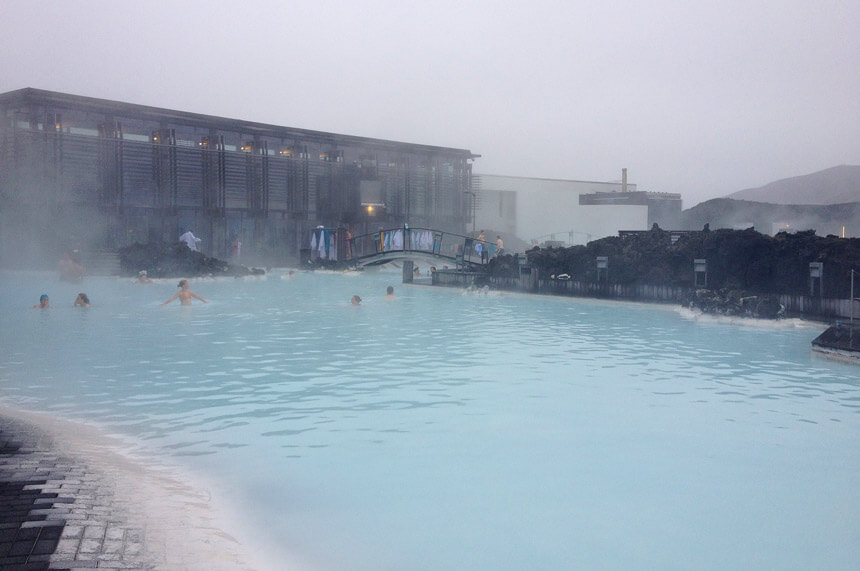
Aside from seeing the northern lights, visiting the Blue Lagoon while it’s snowing is one of the most magical experiences you can have in Iceland. Relaxing in the warm, mineral-rich water while looking out on a frozen lava field is absolutely astonishing and was definitely one of the highlights of my trip to Iceland.
Katie from Two Wandering Soles told me about her visit to the Blue Lagoon in winter:
“The Blue Lagoon is undoubtedly the most popular of the hot springs in Iceland. Luckily, it’s open to guests all year round, making it a perfect wintertime activity, even if you have just a short layover.
“While on a quick 24-hour stopover in Iceland, my mom and I visited this famed blue pool that draws visitors in the hundreds of thousands each year. Honestly, I didn’t have high expectations, as I thought it would be an overpriced tourist trap. However, when we arrived at 11 a.m., the sun was just beginning to rise and cast a beautiful glow across the steamy pools.
We stayed in the water, enjoying our complimentary beverages and face masks until we had to get ready to head to the airport. Even though it was just a few hours later in the mid-afternoon, the sun was already starting to set, once again making this beautiful place even more magical.
“I have since been back to the Blue Lagoon during August, and while both visits were great, I actually enjoyed the wintertime more. There’s just something about soaking in hot springs when there’s a thin layer of snow on the surrounding rocks and a wintery chill in the air. Plus, that perpetual sunrise and sunset glow made the experience all that much more memorable.“
4. See amazing waterfalls (some of them frozen!)
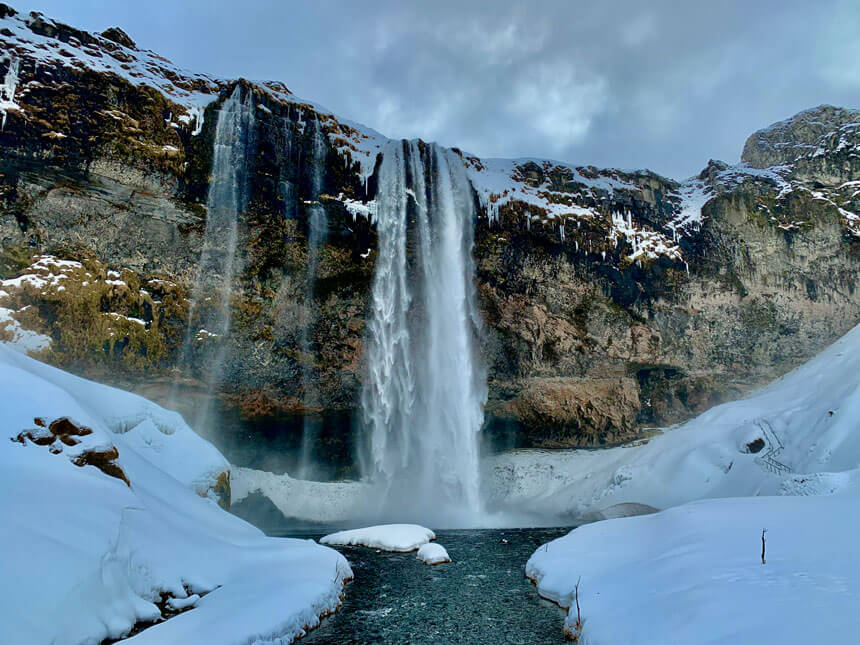
While the Golden Circle is awesome, I had the happiest day of my life on a tour we did of South Iceland. Getting a little bit further south of Reykjavik allows you to see iconic sights like the Skogafoss and Seljalandsfoss waterfalls.
Seeing the sights in South Iceland in winter means there might be a few compromises, but nothing that really affects your enjoyment of the tour. The only thing you may miss out on is at the Seljalandsfoss waterfall, which famously has a path behind it; the path is often closed for safety in icy weather but I was able to go behind the waterfall when I visited in early February.
Rasika from Bae Area and Beyond told me about seeing frozen waterfalls on her trip to Iceland:
“I visited Iceland with my college friends in March and it was cold but not freezing. We drove around western and southern Iceland and since it was winter, we planned to spend about half an hour in each spot so we didn’t get too cold. We spent around half an hour at the waterfall, Kirkjufellsfoss, which translates to Church Mountain Falls.
“Even though there was snow and ice all around, it was possible to hike up and down from the top of the waterfalls. There is an elevated path to hike up to the top of the waterfalls and there’s a bridge to walk across the top of the waterfalls. Apart from the beauty of the waterfalls, we could also see the Kirkjufell mountain above the waterfalls.”
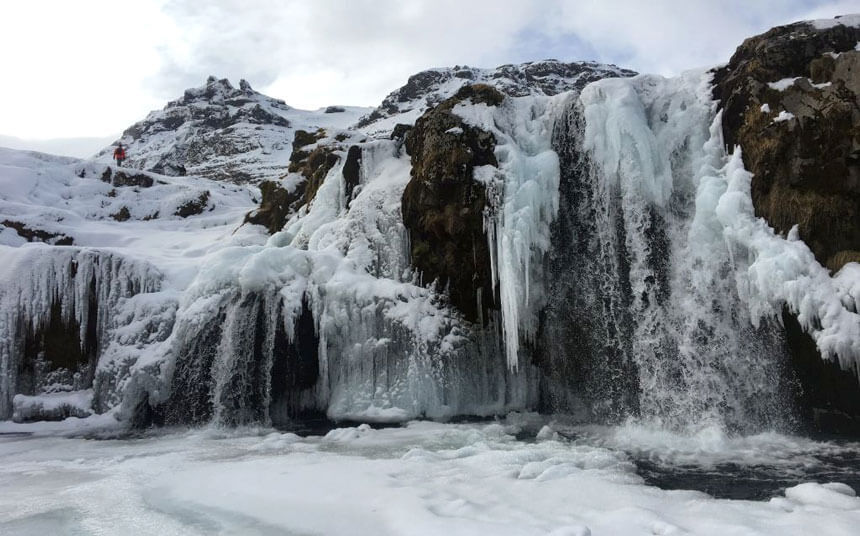
5. Go inside a glacier cave
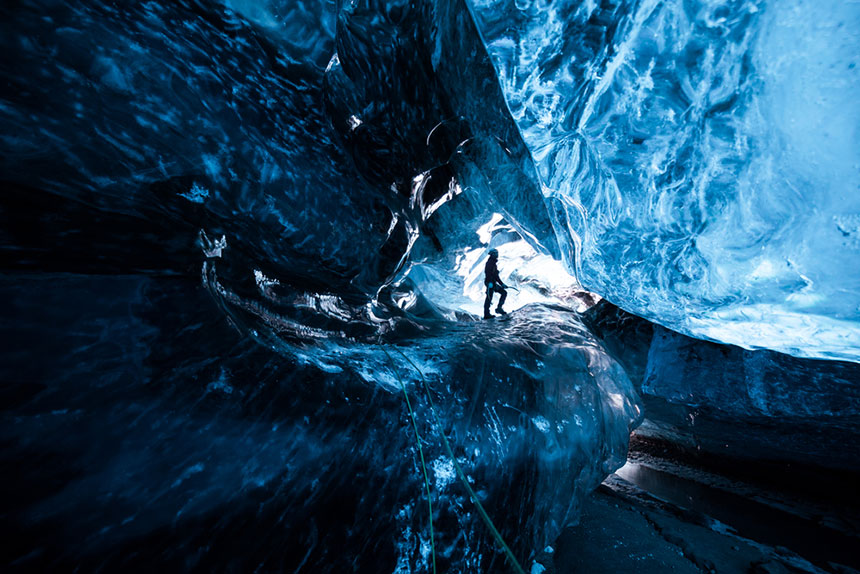
Along with seeing the northern lights, going inside a glacier cave is one of the activities that you can only do in winter in Iceland. I asked fellow travel blogger Victoria from Iceland Trippers to tell me about her experience.
“Visiting a glacier cave is truly one of the most unique things to do in winter in Iceland, as they only exist during the cold months. Once it warms up, it isn’t safe to go inside the ice caves and they melt until the next year where you can visit them again. No two ice caves in Iceland are the same, even year after year, as they will melt and refreeze again!
“Now, you cannot just drive up and visit a glacier cave on your own. There are many Iceland glacier tours to choose from and you must take one for safety. You will go with a local guide who will prepare you in the proper gear, teach you about safety, and guide you every step of the way. Glaciers are very dangerous and if you don’t know where is safe and where isn’t, things can go wrong very quickly!
“You will hike to the entrance of the cave and then go inside. You may have to climb inside or walk inside depending on the type of tour you are on. Once you are inside, it is one of the most epic things you will see! We are photographers so being surrounded by pure blue ice is something out of a dream. It is very cold inside, so make sure to dress warmly. We always wear waterproof gloves as you will be touching ice.
“Glacier caves are spread out through many parts of Iceland, but the most popular areas are the west and the south for finding these tours. You really shouldn’t miss this when visiting Iceland in winter!“
6. Drive the ring road
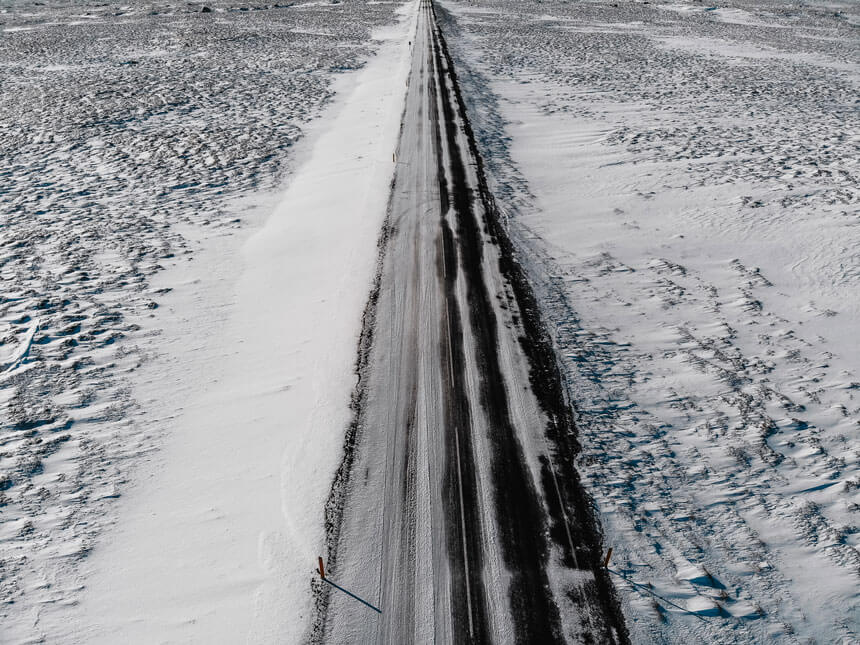
If you have a week or more to spend in Iceland, driving the road that circles the island is a popular way to see more of the magnificent scenery. I didn’t have enough time on my trip to Iceland to drive the ring road so I asked Amy from Oceans to Alpines to let me know what it’s like to do a ring road tour of Iceland in winter.
“The ring road, also known as Route 1, encircles Iceland. This route is a popular road trip amongst tourists, but what is it like during the winter? The road varies from a one lane road to two lane paved road. So the road itself is well maintained. It’s the weather that makes it difficult as you will be driving through large stints of nothingness between those popular tourist attractions.
“There will be snow and ice on the road. But what will get you the most is the wind. There will be areas with snow drifts or snow pile ups on the road and if you aren’t paying attention or have low visibility those can be rough to hit.
“During the wintertime the easiest portion of the road to visit is the southern route, the northern route is far more difficult to navigate. During my drive, I saw two cars flipped.
“So, is driving the ring road in winter doable? Yes. But I would expect the driver to be very experienced or extremely cautious.”
7. Spend a day in Reykjavik
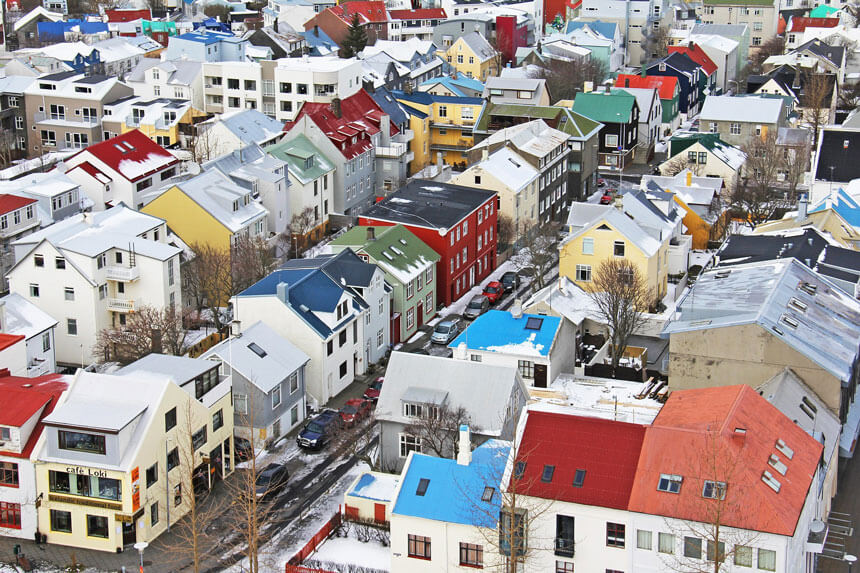
Even if you don’t have much time in Iceland, try to make some time to explore the capital city. On our first day we explored the city, making the most of the daylight. Although Reykjavik is small, there’s plenty to fill a day’s sightseeing and lots of interesting bars, restaurants and concert venues for when the sun goes down.
One of the strangest and most awesome things about a trip to Reykjavik in winter is that you don’t need to worry about slipping on the pavements as you’re walking around. Almost all the pavements in central Reykjavik have pipes under them carrying warm, naturally geothermically-heated water – a kind of under-floor heating for the city that keeps them clear of snow and ice.
8. See Diamond Beach
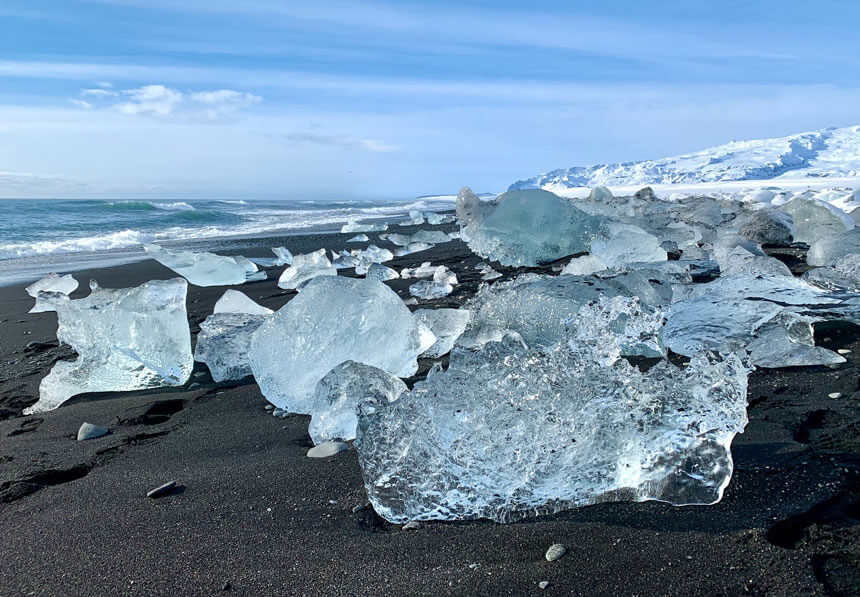
I asked Victoria from Guide Your Travel to tell me what it’s like to visit beautiful Diamond Beach in winter.
“Diamond Beach is a magical place located in south west Iceland and one of the top tourist attractions in the country.
“Diamond Beach gets its name because large chunks of ice are washed up on shore that can sometimes look similar to diamonds. While you can see the diamonds year-round they do tend to be a bit larger in winter. You’ll also have a chance of seeing the northern lights at Diamond Beach in winter which makes it even more magical.
“Diamond Beach in winter will be freezing cold and extremely windy so bundle up warm. If you decide to drive to Diamond Beach in winter, be careful. The roads can be extremely dangerous and icy during the cold season and accidents are common on the route from Reykjavik to Diamond Beach.“
Iceland at Christmas
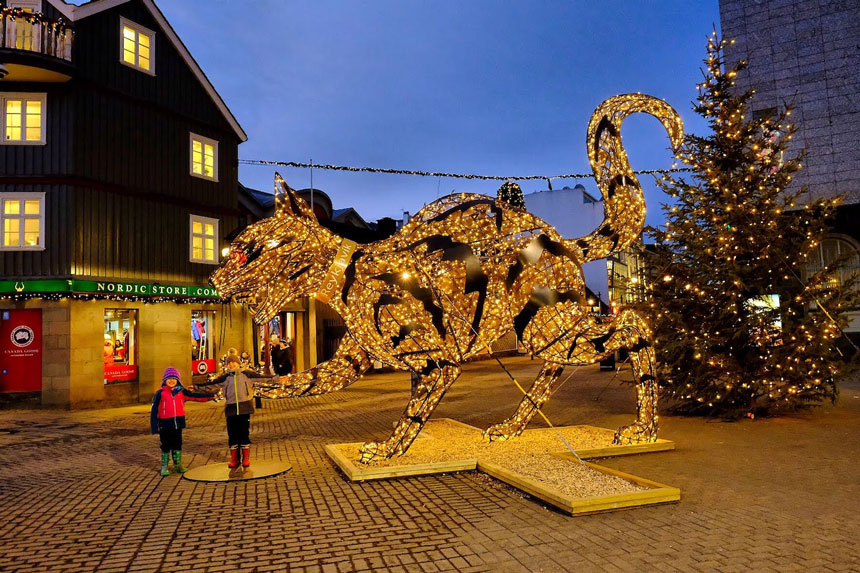
Christmas can be a magical time to visit Iceland. Icelanders have some awesome Christmas traditions and Reykjavik looks like a fairytale with all the Christmas lights shining out in the dark nights. Ania from The Travelling Twins told me what it’s like to take a family holiday to Iceland at Christmas time:
“If you’re looking for a Christmas experience that’s different from the same old routine, consider visiting Iceland. It’s not only an amazing place to see during the holidays but also offers many opportunities for kids and adults alike!
“Our Christmas trip to Iceland wasn’t thought through. We wanted to see Iceland and the Northern Lights, and there was an option to go there for Christmas, so we all decided why not. What we didn’t take into consideration – which is rather obvious right now – was the length of the day. In December in Iceland, sunrise could be as late as 11.30 am and sunset at 3.30 pm.
“Christmas in Iceland is truly magical. The gift-giving starts 13 days before Xmas when every night you should leave your shoe on the window sill and some treats for the Yule Lads. If you were good for 13 days, you would be getting presents in your shoes and then even more on Christmas Day.
“We loved our Christmas time in Iceland, and we would recommend it to everyone.”
What to wear for your winter trip to Iceland
I followed the general advice on the internet which was to layer up, but I didn’t go mad with technical outdoor wear. On days when we were sightseeing around Reykjavik, I wore a thin, long-sleeved thermal top with a merino wool jumper on top.
On my lower half I wore cheap but warm fleece-backed tights from Primark with leggings over the top and a skirt. I did invest in a good coat (mine was from Didriksons) and warm waterproof boots (mine are Merrell – I still wear them all the time in UK winters). Add a hat, fleecy neckwarmer and gloves and I was nice and warm and still felt city-break appropriately dressed rather than like I was off to scale Everest.
On our excursion days to the Golden Circle and Southern Iceland I added a fleece underneath my big coat (but didn’t really need it) and wore thermal leggings (Uniqlo) underneath fleece-lined waterproof trousers. I also had to go swimsuit shopping (horror!) for the Blue Lagoon.
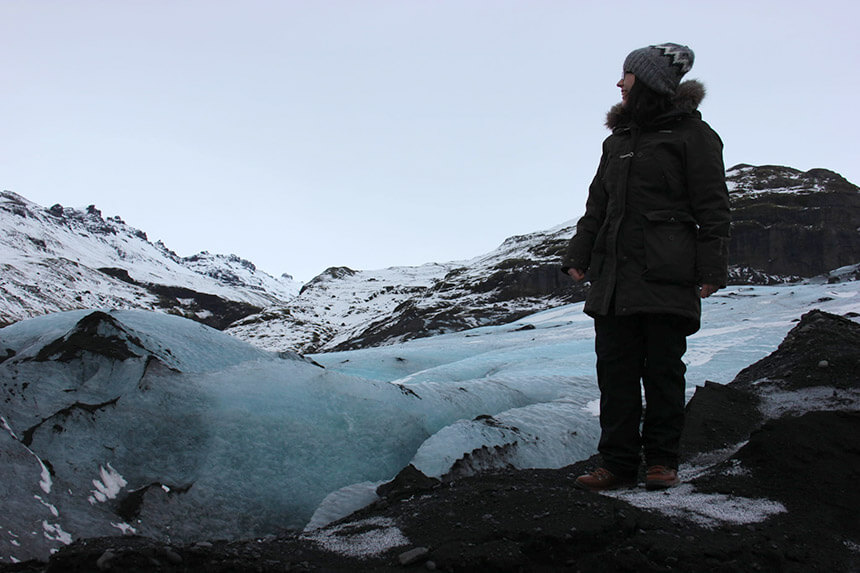
Anything else I should pack for Iceland in winter?
Understatement of the year, but you’re going to want a camera. One of my biggest life regrets (seriously) is that I went to Iceland with only a rather outdated phone camera. Don’t be like me. Take a camera. And if you can, take extra batteries for your camera, as cold temperatures can mean your batteries run down more quickly.
Also, if your phone isn’t waterproof, you might want to get a waterproof single use film camera for the Blue Lagoon. It was an extra bit of retro fun once we were home to go and get the film developed. If I went back I’d take the cheap GoPro alternative that I bought recently.
As well as plenty of warm clothes, it’d be a good idea to bring some hand warmers – little sachets which when activated are a useful extra source of warmth. They’d be particularly useful for Northern Lights tours when you can be stood around for half an hour or more in the middle of the night looking at the sky.
Where should I stay in Reykjavik in winter?
Iceland was expensive when we visited and gets more expensive the more people want to go there. I often see deals with a reasonably priced hotel but it turns out to be outside the city centre or even way out by the Keflavik airport. If at all possible, and especially if you don’t have a car, you’ll want to be within walking distance of the city centre.
Because we were there on an Icelandair package we had a choice of their hotels and chose the Icelandair Hotel Reykjavik Marina because it was so close to the city centre. It’s right on the marina and has dry docks outside the windows framed by the mountains across the bay. The hotel is home to one of the coolest bars in Reykjavik, Slippbarinn, so you don’t even need to go outside for nightlife. The fabulous fire pit in reception was very welcome to warm up after a chilly day sightseeing.
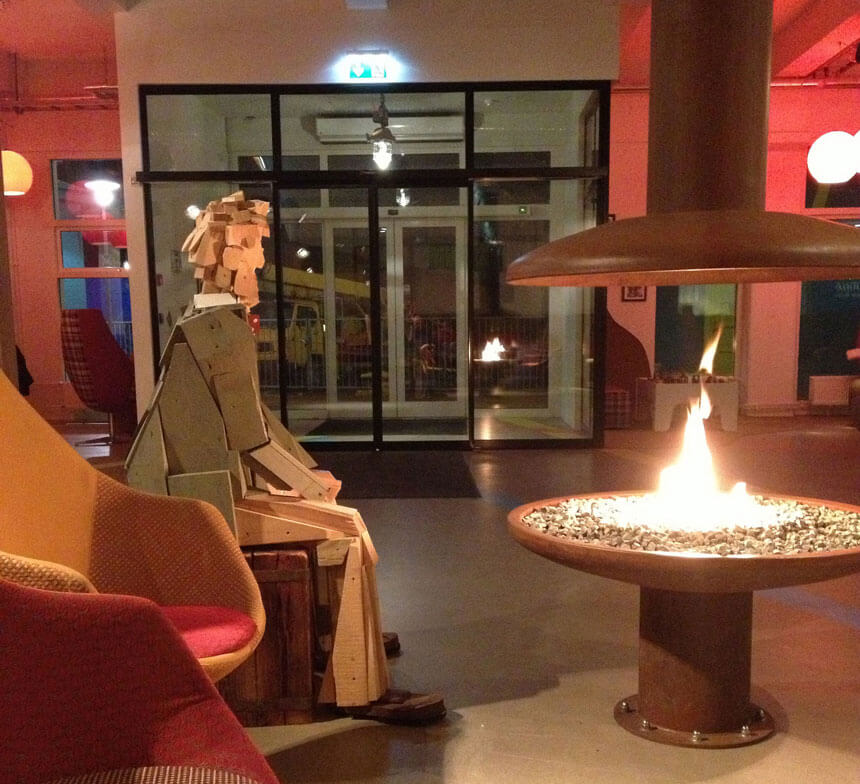
How should I get around Iceland in winter?
If you’re staying in or near Reykjavik city centre then all the city sights should be walkable from your hotel. There’s a shuttle coach service from the airport into town; you might have to change coaches at a bus station on the outskirts to get to your hotel. It takes about an hour to get from the city centre to the airport.
We didn’t rent a car but if we had we would definitely have got a 4×4. On our Southern Iceland tour we were driving through a blizzard and there were overturned cars from previous crashes abandoned at the side of the road (slightly alarming!), so unless you’re very used to driving in wintry conditions and you have a car that’s up to it then I’d recommend taking organised bus tours.
Our Northern Lights trip with Reykjavik Excursions was included in our flight and hotel package and all our other trips were with Bustravel Iceland who gave us a really good price for a combination deal.
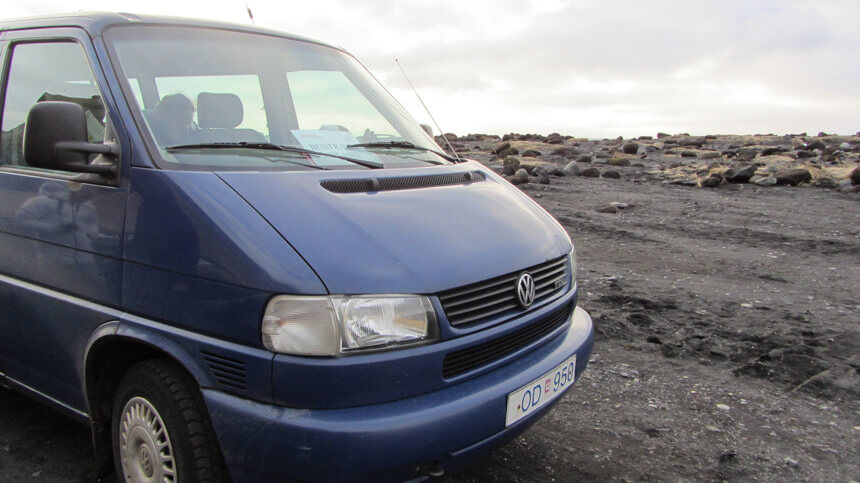
Our itinerary for five days in Iceland in February
We found our five night stay in Reykjavik just right for a first taste of Iceland. Our itinerary looked like this:
Day 1: Arrive in Reykjavik
Day 2: Explore Reykjavik
Day 3: Southern Iceland tour (full day)
Day 4: Golden Circle tour (full day)
Day 5: Blue Lagoon (pretty much full day, I had major wrinkly fingers because we were in there so long!)
Day 6: Early flight home
Would you visit Iceland in winter?
Pin it for later!
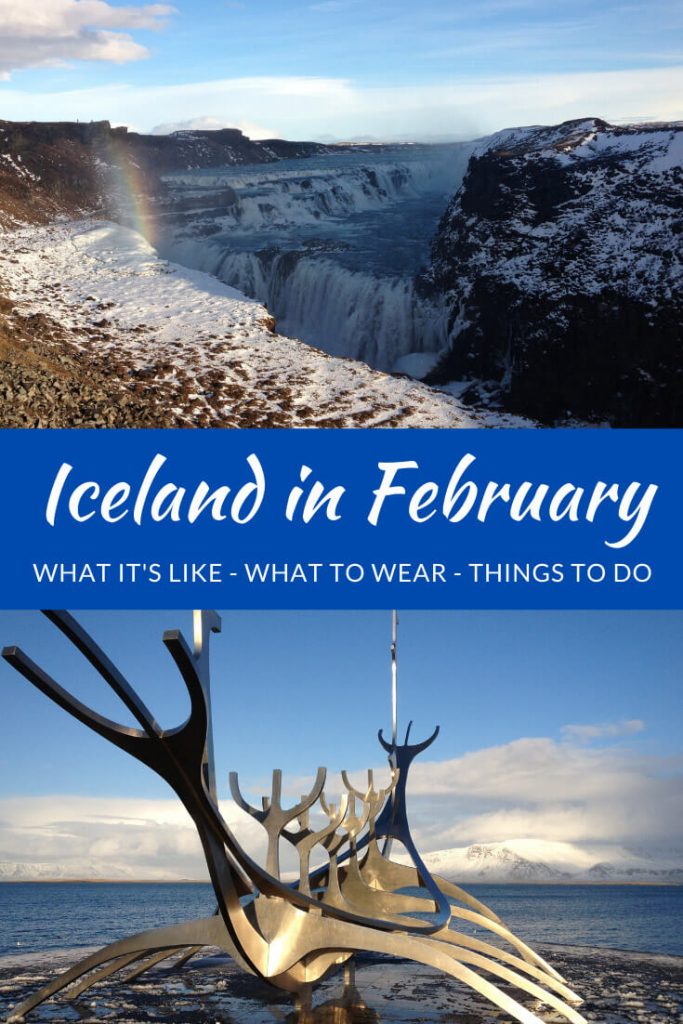

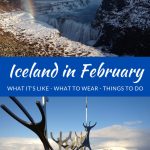
I’ve definitely considered Iceland in the winter. I imagine you may be able to have some places to yourselves sometimes? I love off season for that reason. I would probably freeze, but I’ll consider winter for the northern lights and less crowds.
It was pretty quiet in quite a few places and the streets in Reykjavik were quiet at night so it was nice. It was a few years ago though so I can imagine it’s a bit more difficult to find peace and quiet at the main sights in Iceland now. I totally agree with you on off-season being a great option!
The blue lagoon just looks so cozy and inviting! I want! (As I sit in Thailand in the sweltering heat).
Haha it was wonderful – the only thing that could have made it better would have been if it was snowing 🙂
Lovely guide! I’ve visited Iceland twice – both times in November – and I think a February visit is just the same in terms of packing and weather. Also I totally second spending five days in Reykjavik. I find the city such a fascinating place to explore!
Thanks Flora, I think November and February would be very comparable. Was the city decorated for Christmas when you went? I can imagine it being absolutely amazing at Christmas time!
Great post. I also enjoyed Iceland in the winter, except the short days! Now I want to go back in the summer!
Same, I really want to go back in June when the days are really long and drive the Ring Road 🙂
Iceland look amazing in February, Helen! It seems you had great journey!
Thanks, it was awesome!
I love your photos. Visiting Iceland in winter is like a whole new experience. We’ve been there in the country twice and both times were in Autumn. Now, I’m tempted to go in winter, I’m just afraid I can’t handle the cold. The icy waterfalls looks magical! 🙂
http://www.LovedAndWanderlust.com
Thank you, next time we’re going for my birthday so we’ll get to experience the midnight sun 🙂
We are so excited about our visit to Iceland. We want to visit in March and keep on hearing amazing things. I love how beautiful the landscape is and we simply can’t wait to take pictures with all those crazy waterfalls.
It’s the best place ever, there’s just something completely magical about it! I hope you love it, how long are you staying?
I’m really jealous of your trip. I’m wanting to go to Iceland for a long time. But I won’t forget to carry my camera. 😉
Haha no don’t forget your camera! I hope you get to go soon 🙂